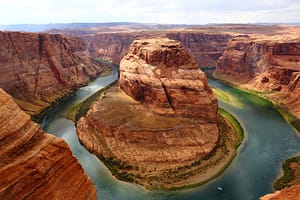The park was founded as Grand Canyon National Monument in 1908 by President Theodore Roosevelt, and became a national park in 1919. Today the park contains over 1.2 million acres (490,000 ha), slightly less than the entire state of Delaware, and in 2004 received more than 4.3 million visitors.
Throughout the past century, hundreds of authors have attempted to depict the enormous landscape that is Grand Canyon. Not surprisingly, words most often fail to invoke the sense of awe and wonder that many visitors experience. Edward Abbey, a noted Southwest author, once penned: “Those who love it call it the canyon. The canyon. As if there were no other topographic feature on the face of the Earth”.
There are, of course, other canyons on the planet. Some are longer, others wider, and even some that are deeper. Canyon visitors are often surprised to learn that Grand Canyon sets no records for sheer size. It is, however, simply regarded by most as the “grandest” canyon of them all.
Geologically, the canyon extends from Lee’s Ferry near the Arizona/Utah border to the Grand Wash Cliffs near Las Vegas, a distance of 277 mi (445 km). It ranges in width from about a quarter mile to over 18 mi (29 km) wide. In places the canyon is over a mile deep.
However, it is not the statistics that define this landscape as “grand”, but rather a combination of factors. The desert environment and a lack of herbaceous ground cover reveal a geologic story that is unparalleled. Surprisingly, the rock layers displayed at Grand Canyon show little sign of wear. The layers have been preserved almost perfectly, as though they were layers in a cake. Nowhere else on Earth displays so many volumes of the planet’s history in such pristine condition.
Arguably, the most famous animal in the park is the rare California Condor. They can occasionally be seen flying near Grand Canyon Village on the South Rim. Common bird life includes Canyon Wrens, Stellar’s Jays (with their peaked caps), swallows, hummingbirds, and the playful and entertaining Raven.
Mule Deer are common. Some of the largest Elk in North America can be found in the national park, and in the adjacent Kaibab National Forest. Desert Big Horn Sheep are also seen on occasion, mainly in the inner canyon.
You’ll often spot Coyote no matter where you are in the park, and if you’re lucky, you’ll get to hear them sing. Other predators are Mountain Lions and Bobcat. Black Bears are rare, and they generally stay away from the inhabited areas.
Some of the smaller creatures that can be found in the inhabited areas of the park are the Ringtail (called a cat, but not in the cat family), which like to live in the rafters of some of the historic buildings on the rim. They are quick and stealthy, but they often forget how visible that tail is, and you’ll see it hanging out over a beam.
A favorite with visitors is the Abert’s Squirrel with their tufted ears. Other varieties of squirrels and chipmunks are also popular. They seem tame and like to beg for food behind the Bright Angel Lodge, near the Ice Cream fountain. But heed the warnings and resist the urge. One of the most common injuries in the park are squirrel bites.
For the reptile family, there are variety of small lizards, and a few snakes. The most striking (in more ways than one) is the Grand Canyon Rattlesnake; with its reddish (almost pink) coloring it neatly blends into the rocky terrain of the canyon.

